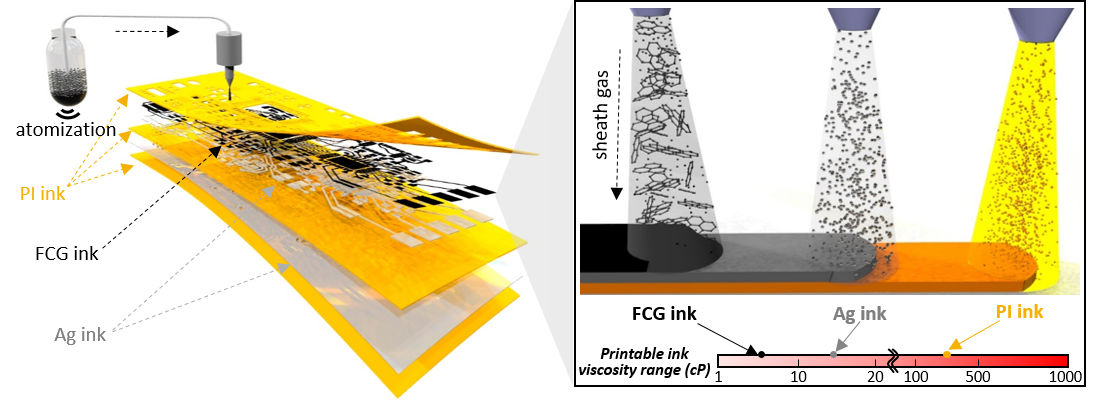Printed Nanomembrane Wireless Bioelectronics
Published in Electrical & Electronic Engineering

One and a half years ago, we got a question of how to manufacture high-performance, flexible, and wearable bioelectronics without the use of the conventional cleanroom fabrication processes. This paper, entitled All-printed nanomembrane wireless bioelectronics using a biocompatible solderable graphene for multimodal human-machine interfaces, answers the initial question that we had via the development of a new class of an additive nanomanufacturing.
This work shows the first demonstration of all-printed, nanomembrane, wireless soft electronics using multiple nanomaterials to construct high-performance sensors and circuits. New findings and advanced engineering of nanoparticle printing methods (Fig. 1) offer a unique way of nanodevice fabrication, which avoids using any cleanroom facility, layer-by-layer photolithography, or multi-step transfer printing.

Fig. 1 Schematic illustrations of printing of aerosol nanoparticles from polyimide (PI), silver (Ag), and functional conductive graphene (FCG) inks to construct a multi-layered structure. The atomized droplets in a nitrogen gas stream are directed to the print head to draw desired patterns on a flexible substrate.
One of the key technological advancements is using a functionalized conductive graphene with enhanced biocompatibility, anti-oxidation, and solderability, which allows us to build a wireless, high-performance flexible circuit. The high-aspect-ratio graphene, laminated on an elastomeric membrane, offers gel-free, high-fidelity recording of muscle activities on the forearm. In addition, anatomical study with deep learning-embedded electrophysiology mapping allows for an optimal selection of three sensor channels to successfully capture all finger motions with an accuracy of about 99% for seven classes (Fig. 2).

Fig. 2 a, Schematic illustration (top) showing target muscles on the forearm to recognize multiple gestures and photos (bottom) capturing three bioelectronics. b, Mapping data showing muscle signals from multiple channels that cover the entire forearm; six different heat maps are obtained according to six gestures, including hand closed, thumb, index, middle, ring, and little finger motion. c, Demonstration of a wireless, wearable device to precisely control a flying drone (left), RC car (middle), and presentation software (right). d, 3D plot of three-channel, muscle signals for clear differentiation of seven different gestures. e, Summarized result of real-time, confusion matrix from ten trials, showing ~99% accuracy across seven classes.
Collectively, this paper represents a major shift in how additive nanomanufacturing can be used for building wireless flexible nanoelectronics and persistent human-machine interfaces when combined with deep learning algorithms.
For more details about our journey, please see the published article in Nature Communications or email Dr. Yeo directly at whyeo@gatech.edu :
Follow the Topic
-
Nature Communications

An open access, multidisciplinary journal dedicated to publishing high-quality research in all areas of the biological, health, physical, chemical and Earth sciences.
Related Collections
With Collections, you can get published faster and increase your visibility.
Women's Health
Publishing Model: Hybrid
Deadline: Ongoing
Advances in neurodegenerative diseases
Publishing Model: Hybrid
Deadline: Dec 24, 2025




Please sign in or register for FREE
If you are a registered user on Research Communities by Springer Nature, please sign in